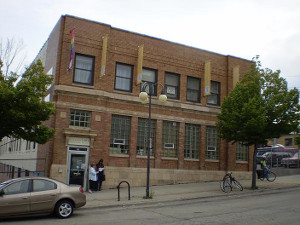
Photo by BlowSky, 2007.
Introduction
In the summer of 2012, posters reading "MORE GRINDR=FEWER GAY BARS” appeared taped to signposts in numerous gay neighborhoods in North America—from Greenwich Village in New York City to Davie Village in Vancouver, Canada.[1] The signs expressed a brewing fear: that the popularity of online lesbian, gay, bisexual, transgender, and queer (LGBTQ) social media—like Grindr, which connects gay men based on proximate location—would soon replace the bricks-and-mortar institutions that had long facilitated LGBTQ community building. The owner of Quest, a popular gay bar that hosted drag nights in Baltimore’s Highlandtown neighborhood for almost fifteen years, blamed the bar’s closure in 2014 on, among other changes, the popularity of gay “hook up” apps like Grindr.[2] There are no studies that definitively prove what, if any, role online technology has played in the number of LGBTQ bars still remaining. But the concern that one social environment would replace the other points not only to the continued growth of LGBTQ virtual life—which has been an important means of exchange across boundaries of geography, accessibility, and age since the 1990s—but also to the historically significant role of bars and other sites of leisure in fostering LGBTQ sociality and of the key role of communication networks in the history of LGBTQ community formation.[3] Read more » [PDF 2.4 MB]
[1] Steve Weinstein, “Nightlife Suffers as Gay Men Move Online,” Village Voice, June 2012; the signs in Vancouver are noted by Amin Ghaziani in There Goes the Gayborhood? (Princeton: Princeton University Press, 2014).
[2] Kevin Rector, “Looking Out: Quest Bar in Highlandtown to Close This Weekend After Last Hurrah,” Baltimore Sun, August 7, 2014. Quest Bar was located at 3607 Fleet Street, Baltimore, Maryland near Brewer’s Hill and was popular with regulars from there and the nearby suburb of Dundalk. See Michael Farley, “Leaving the Gayborhood,” City Paper, June 10, 2014.
[3] For an excellent history of communication networks in fostering the growth of lesbian and gay communities see Martin Meeker, Contacts Desired: Gay and Lesbian Communications and Community, 1940s-1970s (Chicago: University of Chicago Press, 2006). For a study of the vexed uses of early gay online networks see John Edward Campbell, “Virtual Citizens or Dream Consumers: Looking for Civic Community on Gay.com,” in Queer Intersections: Revisiting Online Media and Queer Sexualities, eds. Kate O’Riordan and David J. Phillips (New York: Peter Lang, 2007). See also Johnson, Hutchins, and Schweighofer (this volume).
The views and conclusions contained in the essays are those of the authors and should not be interpreted as representing the opinions or policies of the U.S. Government. Mention of trade names or commercial products does not constitute their endorsement by the U.S. Government.
Part of a series of articles titled LGBTQ America: A Theme Study of Lesbian, Gay, Bisexual, Transgender, and Queer History.
Previous: LGBTQ Spaces and Places
Last updated: October 10, 2016
